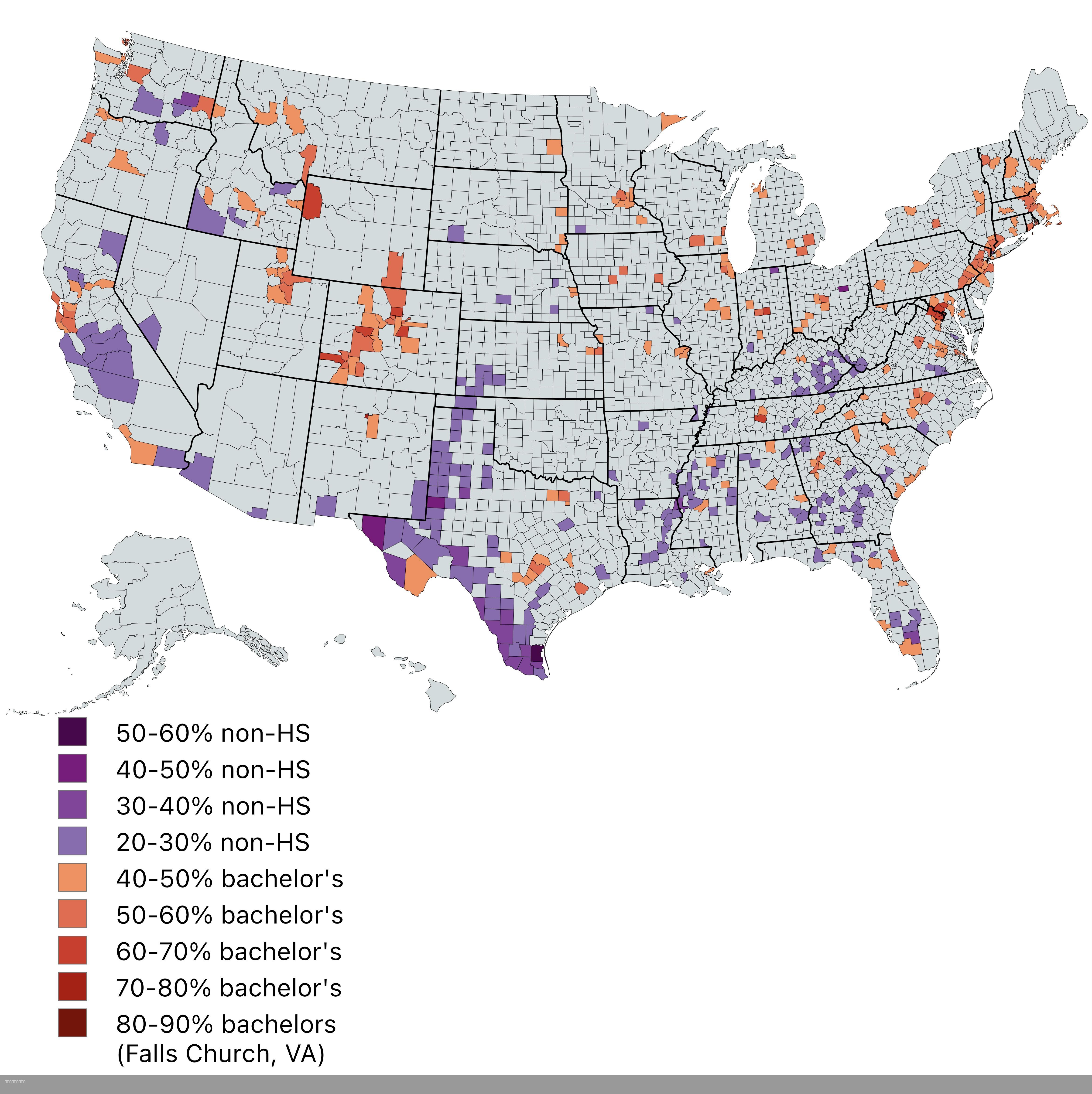Map of Most and Least Educated US Counties


Alex Cartwright
Senior Cartographer & GIS Specialist
Alex Cartwright is a renowned cartographer and geographic information systems specialist with over 15 years of experience in spatial analysis and data...
Geographic Analysis
What This Map Shows
This map presents a striking contrast between the most and least educated counties in the United States, showcasing areas with the highest percentage of non-high school graduates against those boasting the most college graduates. Education is a pivotal factor in shaping communities, influencing economic opportunities, health outcomes, and overall quality of life. By examining this visualization, we can gain valuable insights into educational disparities across the nation and understand the broader implications for society.
Deep Dive into Education Disparities
Education levels serve as a critical indicator of a community's socioeconomic health. The counties with the highest rates of non-high school graduates often grapple with numerous challenges. For example, these areas may experience higher unemployment rates, increased poverty levels, and limited access to healthcare and social services. This can create a cycle of disadvantage that is difficult to break. Interestingly, studies have shown that individuals without a high school diploma are more likely to live in poverty and face barriers to employment, as many jobs today require at least a high school education.
On the other end of the spectrum, counties with the highest percentage of college graduates tend to enjoy stronger economic stability and growth. These regions often attract businesses and industries that value a skilled workforce, leading to higher wages and better job opportunities. For instance, counties like Fairfax in Virginia and San Francisco in California are well-known for their high educational attainment levels, which have contributed to their vibrant economies and overall prosperity.
The implications of education extend beyond mere employment; they influence health outcomes as well. Research indicates that individuals with higher levels of education are more likely to engage in healthier lifestyles, access healthcare services, and live longer lives. This correlation between education and health underscores the importance of addressing educational disparities to improve community well-being.
Regional Analysis
When examining the map, notable patterns emerge that reflect regional differences in educational attainment. For instance, the southern United States often features counties with higher rates of non-high school graduates. Areas like rural Mississippi and Arkansas illustrate how socioeconomic factors, such as poverty and limited access to educational resources, contribute to lower graduation rates.
Conversely, urban centers on the coasts, such as New York City and Los Angeles, show a significant concentration of college graduates. These cities benefit from diverse populations, extensive educational institutions, and a range of industries that require higher education credentials. Interestingly, the disparity is not only geographic but also racial and ethnic. For example, some minority communities face systemic barriers that hinder educational attainment, reflecting broader social inequities.
Midwestern counties also present a mixed picture, with some areas like Minneapolis showcasing high education levels, while others struggle with lower attainment rates. This variation often relates to economic opportunities available in the region, with urban areas typically providing more access to higher education institutions compared to rural counterparts.
Significance and Impact
Understanding education disparities is crucial because they have far-reaching implications for society. Education is a key driver of economic development; communities with higher educational attainment are better positioned to adapt to technological changes and attract new industries. Moreover, as the global economy continues to evolve, the demand for skilled labor is expected to rise, making education even more critical for future generations.
Addressing these disparities requires a multifaceted approach, including investments in early childhood education, improved access to high schools, and enhanced support for community colleges. Policymakers and educators must work collaboratively to ensure that every individual, regardless of background, has the opportunity to achieve their educational potential. The ongoing debate about educational funding, curriculum reform, and access to technology is more relevant than ever in this context.
As we look to the future, it's essential to monitor these trends and continue striving for equity in education. Have you noticed how education shapes not only individual lives but entire communities? The data presented in this map emphasizes that educational attainment is a key factor in defining the health and prosperity of our society. By prioritizing education, we can foster a more equitable and prosperous future for all Americans.
Visualization Details
- Published
- August 2, 2025
- Views
- 110
Comments
Loading comments...